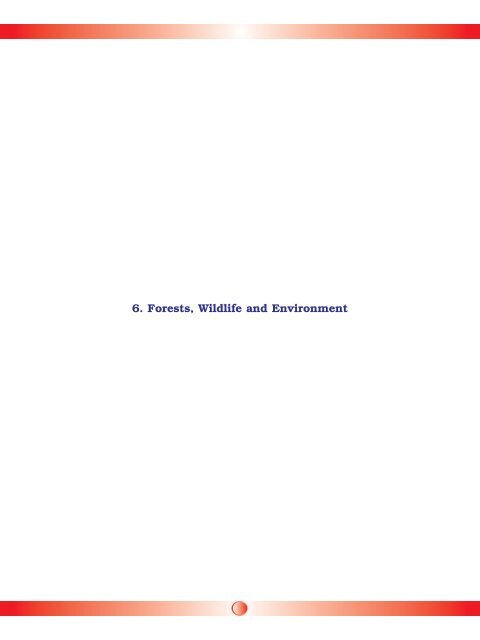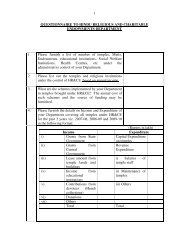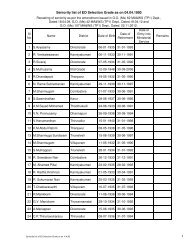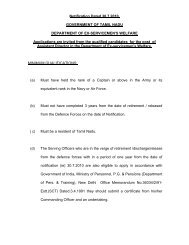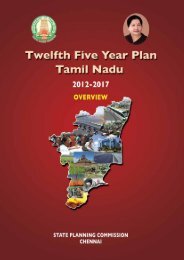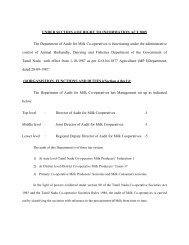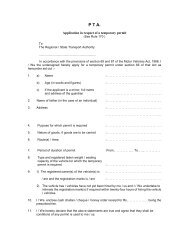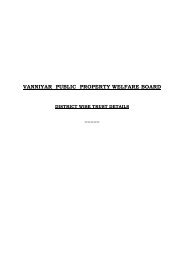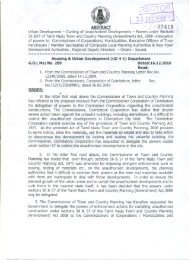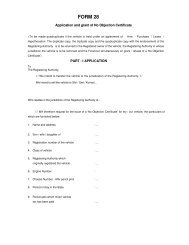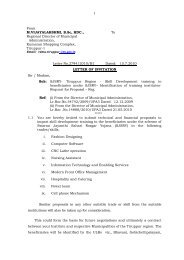6. Forests, Wildlife and Environment - Tamil Nadu Government
6. Forests, Wildlife and Environment - Tamil Nadu Government
6. Forests, Wildlife and Environment - Tamil Nadu Government
You also want an ePaper? Increase the reach of your titles
YUMPU automatically turns print PDFs into web optimized ePapers that Google loves.
<strong>6.</strong> <strong>Forests</strong>, <strong>Wildlife</strong> <strong>and</strong> <strong>Environment</strong>
<strong>6.</strong>1.1. Introduction<strong>6.</strong>1. <strong>Forests</strong> <strong>and</strong> <strong>Wildlife</strong>Eat your food to satisfy your hunger, <strong>and</strong> drink tosatisfy your thirst. Satisfy the necessities of life likethe butterfly that sips the flower, without destroyingits fragrance or texture- Lord BuddhaThe forest is a complex ecosystem consisting mainly of trees that bufferthe earth <strong>and</strong> support a myriad of life forms. The scientific reasons for theneed to protect forest for the benefits of mankind is well known. The Jainism<strong>and</strong> Buddhism are celebrated as the first religion to propagate rational thinking<strong>and</strong> ethical values. Saint Vardaman preached that materialism <strong>and</strong> religionare interwined <strong>and</strong> the plants <strong>and</strong> birds have life. Gautama Buddha preachedagainst killing of living beings. Buddha attained bliss under the tree afterrenouncing the nation <strong>and</strong> w<strong>and</strong>ering through the forests. Two thous<strong>and</strong>years before, <strong>Tamil</strong>s have classified l<strong>and</strong>s into five categories <strong>and</strong> named theforestl<strong>and</strong>s as ‘Mullai’. The Arthasastra written during the Mauryan ruleclassified forests into three <strong>and</strong> framed rules to protect them. The trees helpcreate a special environment which, in turn, affects the kinds of animals <strong>and</strong>plants that can exist in the forest. Trees are an important component of theenvironment. They clean the air, cool it on hot days, conserve heat at night,<strong>and</strong> act as excellent sound absorbers. People began life on this Planet asforest dwellers. They were food gatherers <strong>and</strong> depended on the forest for alltheir needs: food, clothing, <strong>and</strong> shelter. They gradually became food growers,clearing a small patch in the forest to grow food. But they continued to dependon forests to meet many of their needs. Even today people depend on theforest for paper, timber, fuel wood, medicine, <strong>and</strong> fodder.<strong>Tamil</strong> <strong>Nadu</strong> State is spread over a geographical area of 1,30,058 sq.kms.It has a recorded forest area 22,877 sq. kms. accounting for 17.59% of its totalgeographical area. The Forest cover in the State is 22643 sq. kms. i.e., 17.41%<strong>and</strong> tree cover in the State is 4991 sq. kms. i.e., 3.84%. Total Forest cover <strong>and</strong>Tree cover in the State is 27634 sq. kms. which is 21.25% of the geographicalarea of <strong>Tamil</strong> <strong>Nadu</strong>. This proportion is very much below the National ForestPolicy stipulation of 25% by 2007 <strong>and</strong> of 33.33% by 2012 <strong>and</strong> also below the243
Box <strong>6.</strong>1.1<strong>Tamil</strong> <strong>Nadu</strong> Afforestation Project (TAP) Phase-I(1997-98 to 2004-05) AchievementsDegraded forests <strong>and</strong> other l<strong>and</strong>s over an area of 4.80 lakh ha. hasbeen restored.1367 Village Forest Councils have been formed.More than 1,75,000 forest dependents <strong>and</strong> poorer sections havebenefited by alternate employment.About 3891 Self-Help Groups benefiting around 60,000 women wereformed in all programme villages.Community assets like overhead tanks, borewells <strong>and</strong> h<strong>and</strong> pumps,community halls, threshing floors, ration shops, libraries, balvadis,etc. have been provided to improve the quality of life in all programmevillages.23454 check dams <strong>and</strong> 2201 percolation ponds have been constructedfor rain water harvesting which enabled creating a capacity of morethan 800 million cubic feet of water storage.It has also helped inaugmenting agricultural production.609 lakh person days of labour have been generated in the past eightyears. To increase the tree / forest cover outside the reservedforests, 15 Forestry Extension Centres were established in this project.To utilize Information Technology, a Geomatics Centre was establishedat Chennai. Computerization in Forest Department has been done atthe level of Range Offices.Inter-sectoral linkage was given a major thrust in the Project. Districtlevel JFM Committees have been formed in 27 districts <strong>and</strong> worksworth Rs.60 crore have been implemented in 1115 TAP villages by 22line Departments.249
<strong>6.</strong>1.3 Eleventh Five Year PlanThe National Forestry Policy, 1988 has envisaged that the forest/ treecovern the country would be brought to 25% by 2007 <strong>and</strong> to 33% by 2012.The present forest / tree cover in <strong>Tamil</strong> <strong>Nadu</strong> is 21%. Though there are manysites in <strong>Tamil</strong> <strong>Nadu</strong>, where, potential natural regeneration <strong>and</strong> restoration ispossible, much of it is under agriculture or taken over by urbanisation <strong>and</strong>industrialisation including settlements in the past few years. To bring suchareas under forests <strong>and</strong> to increase the forest <strong>and</strong> tree cover remains a bigchallenge. There is need for bringing all available l<strong>and</strong>s like government,institutional, farm l<strong>and</strong>s, private l<strong>and</strong>s to a large extent under tree cover foldby tree farming.ObjectivesTo enhance tree cover outside forests for livelihood security.To ensure environmental <strong>and</strong> ecological stability of the state.Conservation of biodiversity, wildlife <strong>and</strong> genetic resource.Conservation <strong>and</strong> management of coastal ecosystem.Resource management <strong>and</strong> augmentation of forest protection.Water augmentation through forest conservation <strong>and</strong> catchment areamanagementTo ensure ecological stability <strong>and</strong> economic prosperity through tribaldevelopment.Technology support, research, remote sensing, GIS <strong>and</strong> extensionsfor scientific forest managementTo empower women for sustainable forest management.Human resource management for scientific forestry management.To monitor efficiently the delivery mechanism through Infrastructuredevelopment250
StrategyThe Eleventh Five Year Plan may have to take a new path with emphasison resource mobilization for tree cultivation outside the forest area. The thrustarea of trees outside forests today has emerged as new opportunity not onlyto support increased tree cover but also to improve farm income for the small<strong>and</strong> marginal farmers in the State.This Plan will for the first time seek to engage the rural l<strong>and</strong>less poor <strong>and</strong>the marginal farmers into tree cultivation <strong>and</strong> also support the dynamic growthof the primary sector in the state while also assuring that the forests areprotected <strong>and</strong> conserved for harnessing the expected forest based goods <strong>and</strong>services for the benefit of the people in the State. The following are the majorthrust areas, which includes the important schemes of the department to beimplemented during the Plan period.i. Increasing Tree Cover Outside the Forest Areas of <strong>Tamil</strong> <strong>Nadu</strong><strong>Tamil</strong> <strong>Nadu</strong> is one of the pioneer states that initiated “Community forestryprogrammes” (ie) afforestation in the community l<strong>and</strong>s <strong>and</strong> wastel<strong>and</strong>s asearly as 1960. In the seventies, in pursuance of the interim recommendationsof National Commission on Agriculture, other programmes known as extensionforestry, mixed Plantations <strong>and</strong> village forests were implemented to developtree cover on all available l<strong>and</strong>s for the benefit of the local community. Fromthe year 1997, under the <strong>Tamil</strong> <strong>Nadu</strong> Afforestation Project (TAP), importanceis given to restock/restore the degraded forests. About 20,000 ha of revenue/ community l<strong>and</strong>s have been covered under the component of “Greeningcommunity l<strong>and</strong> “from 1997 to 2002. In fact, after SIDA programme no seriousefforts were made to bring more area under tree cover especially outside theforest area.With the experience <strong>and</strong> confidence gained from SIDA project <strong>and</strong> thesuccessful module evolved for participatory approach under TAP, the forestdepartment of <strong>Tamil</strong> <strong>Nadu</strong> can go for various community forestry programmesin the available community <strong>and</strong> wastel<strong>and</strong>s such as Tankfore shore, Revenuehillocks, canal banks, Riverbeds, Road avenues, Tank bunds, etc. The projectenvisages to bring about 7 Lakh Ha. under tree cover during the Plan period<strong>and</strong> increase the tree cover considerably outside the traditional forest area.The total outlay proposed for this objective is Rs.375.00 crore.251
The objectives are to bring all the barren community l<strong>and</strong>s, wastel<strong>and</strong>s,public, private l<strong>and</strong>s, institution l<strong>and</strong>s, etc. under suitable tree cover in orderto achieve 33% of geographical area of <strong>Tamil</strong> <strong>Nadu</strong> under green cover by 2012.By the end of the Plan period, with the support of extension services allefforts will be made to increase the tree / forest cover to 33% of the l<strong>and</strong> areaas envisaged in the National Forest policy. Tree based business will be given aboost in the state by providing needed technical support <strong>and</strong> encouragementto all the stakeholders.ii. Increasing Forest / Tree Cover Inside <strong>Forests</strong>Even though numerous schemes were implemented, there is still scopefor tree planting inside forest. Continuous efforts to afforest are the only wayto reverse the negative trend.The primary objectives of such an effort are to increase productivity offorest areas, to conserve biodiversity of the area, especially medicinal Plantsto meet the livelihood needs of the local people <strong>and</strong> to provide ecological securityby enhancing crop density inside forests <strong>and</strong> eco preservation <strong>and</strong> ecorestoration by creating tree cover on degraded hills, rocky areas, grassy areas<strong>and</strong> patches inside forest areas, where reclamation is necessary, due to paucityof tree cover. During Plan period, it is proposed to continue the massiveafforestation <strong>and</strong> ecological restoration programmes under Joint ForestManagement model, wherever possible. Further the proposals under variousschemes will be in tune with the working Plan prescriptions. The outlayproposed for this objective is Rs.484.11 crore.iii. <strong>Tamil</strong> <strong>Nadu</strong> Afforestation Project- Phase-II: (Externally-Aided Project)The <strong>Tamil</strong> <strong>Nadu</strong> Afforestation Project Phase-II will continue in the EleventhFive Year Plan. Since the project is an approved ongoing project, the financialimplication for the afforestation works under IWDP <strong>and</strong> ITDP including bufferzone activities for both the components from the year 2007 08 to 2011-12 isincluded. Similarly the physical target included is only for planting activitiesinside the Reserve forest (RF) in the various approved components.252
Check Dam constructed under TAPScheme-Vellore DistrictPercolation pond constructedunder TAP Schemeiv. National Afforestation Programme (NAP): (GOI Project)The National Afforestation <strong>and</strong> Eco-Development Board, Ministry of<strong>Environment</strong> <strong>and</strong> <strong>Forests</strong>, piloted the National Afforestation Programme (NAP)which was implemented during the Tenth Five Year Plan. Merger of variousschemes such as Integrated Afforestation & Eco-development Project, AreaOriented Fuel wood <strong>and</strong> Fodder Scheme were formulated. <strong>Tamil</strong> <strong>Nadu</strong> hasbeen implementing this programme on Watershed basis, under a decentralizedinstitutional structure comprising the Forest Development Agencies (FDA)<strong>and</strong> Joint Forest Management Committees (JFMCs) presuming that theNational Afforestation Programme will be continued in the Eleventh Five YearPlan for <strong>Tamil</strong> <strong>Nadu</strong>. The guidelines as approved by the National Afforestation<strong>and</strong> Eco-Development Board, Ministry of <strong>Environment</strong> <strong>and</strong> <strong>Forests</strong> will befollowed, as it is <strong>Government</strong> of India Project.Though the major part of the work is to be taken up under TAP II <strong>and</strong>NAP, afforestation works <strong>and</strong> forest restoration works will be taken up underthe following ongoing schemes which will be continued in the Eleventh Planperiod.The following on-going schemes of Tenth Five Year Plan are to be continuedduring Eleventh Five Year Plan:<strong>Tamil</strong> <strong>Nadu</strong> Afforestation Project – Phase-IINational Afforestation ProgrammeWestern Ghats Development Programme253
Hill Area Development ProgrammeS<strong>and</strong>al wood PlantationsBamboo PlantationsRaising of Timber <strong>and</strong> Non-timber speciesRaising of oil seeds /bio- fuel PlantationsAfforestation Works Under TAP <strong>and</strong> NAP schemesSelf Help Groups at work in TAP schemes254
V. Biodiversity <strong>and</strong> <strong>Wildlife</strong> Conservation<strong>Tamil</strong> <strong>Nadu</strong> is a home for a rich diversity of flora <strong>and</strong> fauna, bothdomesticated <strong>and</strong> wild, <strong>and</strong> has set aside about 1<strong>6.</strong>03 % of its forest areaunder the protected area network comprising twenty <strong>Wildlife</strong> Sanctuaries,five National parks, three Biosphere Reserve, one Project Tiger <strong>and</strong> one ProjectElephant which are the protected areas. The <strong>Tamil</strong> <strong>Nadu</strong> State has animpeccable history of being a pioneer in protecting <strong>and</strong> conserving biodiversity.Inspite of the best efforts taken over the years in the conservation of biodiversity.The State is still facing challenges to protect its indigenous biodiversitydue to unchecked growth of population of humans <strong>and</strong> the livestock. This hasput tremendous pressure on the existing wilderness areas, which are shrinkingmaking space for economic development. There is also concern about thehabitat from other threats both direct <strong>and</strong> indirect on the biodiversity, whichinclude poaching, illegal smuggling of valuable endangered flora <strong>and</strong> fauna<strong>and</strong> other adverse impacts.During the Plan period, the heterogeneity <strong>and</strong> species diversity in thevarious forest types in the State will be protected <strong>and</strong> conserved. ThroughSpecies Recovery Programme critically endangered species in the WesternGhats will be reintroduced into the original tracts. The ex-situ animal <strong>and</strong>Plant centres i.e., the Arignar Anna Zoological Parks, the mini zoos <strong>and</strong> theGenepool Garden will support conservation along with the in situ conservationcentres. The protected area management will be fully oriented towardsResearch <strong>and</strong> Conservation of the rich Biodiversity. The ongoing scheme workscarried out under GOMBR Trust for Gulf of Mannar Biodiversity Reserve willbe continued till the year 2011.Almost all the wildlife related schemes areimplemented using <strong>Government</strong> of India funding. The outlay for the stateschemes under biodiversity conservation is Rs.37.93 crore.Some of the important centrally sponsored schemes implemented forwelfare of wildlife are discussed below:Night Safari: The Night Safari will be established in Arignar AnnaZoological Park, V<strong>and</strong>alur. The main object is to inspire empathy for the wildanimals among the visitors <strong>and</strong> finally maintaining the ecological balance.The safari will be attraction for the local population, tourists from other States<strong>and</strong> abroad.255
Butterfly Park: Butterfly Park is to be established in Arignar AnnaZoological Park, V<strong>and</strong>alur. Important species of butterflies seen in <strong>Tamil</strong> <strong>Nadu</strong>along with their host Plants will be assembled in the Centre. It will imparteducation to the children about the insect world <strong>and</strong> the role of butterflies.Establishment of Zoo at Trichy: To create awareness among the peopleabout wild animals, the establishment of Zoo at Trichy is essential since thereis no Zoo now at Trichy.Vi. Tribal DevelopmentWith the change in time, there have been changes in the tribal life systemdue to socio – economic development around, but the change for tribals livingwithin the forests have been slow. Multiple agencies like the DistrictAdministration, the Forest Department, the Adi Dravidar Tribal WelfareDepartment <strong>and</strong> others have attended to the needs of the tribals within theforests <strong>and</strong> outside for their development. For the tribals living within theforests, the main source of support has been from the Forest Department.Tribals living within the forest areas have not been subjected to developmentalchanges. However, with the frequent interaction with community outside<strong>and</strong> the market forces, there is a change in their culture <strong>and</strong> consumptionpattern.The Forest Department has implemented various programmes for thedevelopment <strong>and</strong> employment generation of tribals within the forests likeproviding better education to the tribal children through nineteen schools,providing solar lights, improving <strong>and</strong> laying new roads to the tribal settlements,providing safe drinking water etc. Under <strong>Tamil</strong> <strong>Nadu</strong> Afforestation Schemes,various facilities have been provided to the tribals for improving their incomegeneration. Tribals in the forest area have been allowed for free collection ofNon-timber forest produce (NTFP). The outlay for the State schemes proposedis Rs.101.01 crore.Vii. Forest Protection <strong>and</strong> Fire ManagementLarge areas of forest l<strong>and</strong>s are under encroachment. There are severalex-zamin forests worth many thous<strong>and</strong> crore of rupees under various stagesof settlement. Survey <strong>and</strong> demarcation of boundaries of these l<strong>and</strong>s underthe control of the forest department needs to be carried out in a time bound256
manner to avoid further loss of forest l<strong>and</strong>s <strong>and</strong> its consequential fallouts. Theworks to be carried out under forest consolidation are re-fixing of forestboundaries, preparing detailed maps using GPS in the territorial divisions,planting of agave along the Reserve Forest (RF) boundaries in the territorialdivisions, dibbling of Palmyrah nuts along the RF boundaries wherevernecessary at two metre interval in two rows., planting of Acacia mellifera attwo meter espacement will be done over 200 km per year along the RFboundaries, repair <strong>and</strong> maintenance of the existing RF Cairns wherevernecessary at 4000 Nos. per year, construction of new RF Cairns at 20000Nos.per year <strong>and</strong> the identified encroachments will be evicted at Rs. 25,000/- perhectare including the cost of consolidation <strong>and</strong> re-planting by suitable treesat 20 hectare per year.The vulnerable patches in the forest areas, particularly fragile ecosystems,which have been subjected to exotic weed infestations, <strong>and</strong> these are degradingthe ecosystems by affecting the natural regeneration of the native species.Hence the unwanted grass <strong>and</strong> weeds in vulnerable areas will be removed<strong>and</strong> planted with suitable species at 1.5 x 1.5m espacement at 100 ha. perdivision.Forest fire is a major problem facing most of the forest areas of the State.The problem is most acute in the hill areas of Western Ghats <strong>and</strong> EasternGhats. The problem is severe during the months of January to June, till theonset of monsoon. The winter ensures the desiccation of the inflammablematerials in the forests <strong>and</strong> this is aided by frost. The strong winds in summermonths further add to the problem. Graziers, forest abutting estates, negligentactivities of the villagers in the forest abutting villages, ganja cultivators <strong>and</strong>accidental causes from tourists <strong>and</strong> along the roads passing through the forestsare the major causes of the forest fires. The resultant loss to naturalregeneration <strong>and</strong> biodiversity warrants greater focus to tackle this menace.The preventive measures which are proposed to be taken up are RF levelfire prone area maps for all the Reserve forest, formation of village protectioncommittees, special camps for the eradication of ganja <strong>and</strong> other illegalactivities, reward to informers training programme to field staff, providing waterstorage facilities, creation of water impounding structures, mass awarenesscamps, creation of cattle ponds, engaging watchers for fire season, fire tracing,fire line clearing <strong>and</strong> maintenance <strong>and</strong> purchase of fire fighting equipments.257
The infrastructure development proposed the formation of warning centres<strong>and</strong> fire watch towers included during the Plan period in the vulnerable areas,construction of camping shed, construction of check post building, purchaseof ammunition <strong>and</strong> repair <strong>and</strong> replacement of available weapons <strong>and</strong> repair<strong>and</strong> replacement of wireless <strong>and</strong> communication equipment. The proposedoutlay for forest protection is Rs.140.82 croreViii. Infrastructure DevelopmentForest resource management requires a large spectrum of infrastructurewhich include roads, transport, communication, housing, interpretationcentres, rest houses, inspection sheds, hospitality facilities in sanctuaries<strong>and</strong> national parks for efficient protection <strong>and</strong> management of the valuableresources in the State. Today there are nearly 148 IFS Officers <strong>and</strong> 5848 fieldstaff which includes DCFs, ACFs, Rangers, Foresters, Forest gaurds <strong>and</strong> Forestwatchers. There are 1307 office staff in the forest department. To improve theefficiency <strong>and</strong> efficacy of the forest protection machinery of the state <strong>and</strong> tosupport in all the fields of forestry so that the resource is put to its best use<strong>and</strong> also support better conservation by improving the chain of infrastructurefacilities required for staff <strong>and</strong> officers, rest houses <strong>and</strong> inspection sheds areneeded. The outlay for the State schemes for Infrastructure developmentespecially for the improvement of forest roads network is Rs.100.00 crore.ix. Transfer Technology through Research <strong>and</strong> GIS Forestry ResearchThe goal of the research wing of the forest department also will be tomeet the requirement of wood based industries from the produces obtainedfrom trees outside forest area by stimulating the tree growing activity amongthe farming community. The forest research will also focus in ensuring thatthe farmers who take up this activities should be able to get a minimumreturn of Rs.20, 000/- per acre per annum. This is aimed at reversing theurban migration from rural areas. The goal will be to provide prescription fordevelopment of rural economy through forestry, which will result in arrestingthe depletion of l<strong>and</strong> resources, <strong>and</strong> thereby alleviate poverty <strong>and</strong> increasethe contribution of rural sector in the GDP.All the research centres will be strengthened to continue research onthrust areas like tree improvement, seedlings <strong>and</strong> clonal orchard, plantation258
forestry, soil nutrient management, organic tree farming, nursery technology,medicinal plants post-harvest technology <strong>and</strong> silvicultural research. Researchon industrial wood species to support veneer, match, dye <strong>and</strong> other industrialsector will continue. Research on important agro-forestry species will bestrengthened.There is need to use geomatics as a technology in dealing with theissues like natural resource assessment, survey <strong>and</strong> demarcation, developingmonitoring protocols, disaster management <strong>and</strong> planning various mitigationmeasures. The primary objective of the Geomatics Centre is to strengthenfield-based applications of Remote Sensing <strong>and</strong> GIS by making use of latestInformation Technology <strong>and</strong> also contributing to the interpretation, planning,monitoring <strong>and</strong> evaluation of various decisions. All levels of field functionarieswill be exposed to this frontier technology of GIS for better resource monitoring,surveillance <strong>and</strong> threat control. By establishment of regional GIS Labs, thescientific management of forestry practices will be strengthened. The outlayfor the State schemes for forest research <strong>and</strong> GIS is Rs.2<strong>6.</strong>03 crore.x. Human Resource ManagementCapacity building programmes proposed in this proposal are essential<strong>and</strong> this will bring in a sea change in the working atmosphere of the departmenton the whole. The technical <strong>and</strong> managerial training <strong>and</strong> infrastructure facilitiesproposed in the project will bring considerable change in the skill <strong>and</strong> capacityof the personnel working in the Forest Department. This will also providebetter working environment to the individuals who will facilitate to achievethe objectives <strong>and</strong> mission of the Department. By this capacity buildingactivities about 3500 ministerial staff, 1350 forest watchers, 2200 forest guards,1300 foresters, 590 rangers, 50 ACF’s <strong>and</strong> 140 senior officers will get a chanceto improve their working quality <strong>and</strong> their personal development. Thus theover all working environment <strong>and</strong> the quality of working will improvesubstantially <strong>and</strong> this will definitely help to the mission <strong>and</strong> vision of theForest Department during the Plan period. The outlay for the State schemesfor human resource management is Rs.10.10 crore.xi. Empowerment of Women through ForestryIn many forestry schemes based on JFM also, women participation inproject activities is being limited to a labourer / client relationship mostly259
centered around nursery <strong>and</strong> plantation activities with general exceptions.The active participation of women in bio-diversity <strong>and</strong> forest development willhelp improve their family, promote greater equity <strong>and</strong> contribute to their overallempowerment. Hence, this thrust area of women empowerment is proposedto be included in the Eleventh Five Year Plan. Women will be involved <strong>and</strong>their perspectives will be reflected in the policies <strong>and</strong> programmes of theForest Department for conservation gains <strong>and</strong> restoration of degraded forests.The various programmes outlined for the empowerment of women will beimplemented. Women’s contribution to socio-economic development asproducers <strong>and</strong> workers will be harnessed. The outlay for the State scheme isRs 10.00 crore.Coastal Area Conservation And ManagementThe <strong>Tamil</strong> <strong>Nadu</strong> Forest Department have taken up afforestation along thecoastal line in the name of Coastal Shelter Belt Plantations since 1960. Thetotal area under shelterbelt Plantations raised so far is 2239 ha. <strong>and</strong> the totalarea under mangrove Plantations is 2679 ha. Afforestation in the coastalregion was also taken up under other schemes such as National AfforestationProgramme <strong>and</strong> the total area covered is 4087 ha.Most of the vulnerable sea coast stretches will be covered during the Planperiod under shelterbelt. Mangrove system will be enriched through restoration<strong>and</strong> mangroves established to strengthen the coastline <strong>and</strong> the livelihoodsecurity <strong>and</strong> safety will be ensured to people living in the coastal areas throughinterventions by the end of the Plan period. The afforestation works will betaken up with the funding from JBIC <strong>and</strong> other external agencies.Catchment Area ManagementIn <strong>Tamil</strong> <strong>Nadu</strong>, there are 32 river systems, 71 reservoirs, 2,391 canals<strong>and</strong> 40,319 tanks <strong>and</strong> majority of their catchment areas lie in forestl<strong>and</strong>s. Toimprove the forests, an Integrated Watershed Development approach is beingimplemented by undertaking afforestation <strong>and</strong> soil <strong>and</strong> water conservationmeasures in the affected watersheds. Massive soil <strong>and</strong> water conservationactivities are being taken up, as an integral part of all treatment plans atmacro as well as micro levels. These steps would ensure prevention of floods<strong>and</strong> droughts in the adjacent plains besides benefiting vegetation <strong>and</strong> wildlifein forest areas. The works shall be taken up with the funding from <strong>Government</strong>of India (Rs.129.43 crore), NABARD <strong>and</strong> other external agencies.260
Table <strong>6.</strong>1. 2schemes261
<strong>6.</strong>2.1. Introduction<strong>6.</strong>2. Ecology <strong>and</strong> <strong>Environment</strong>One can look at history from two sides <strong>and</strong> divide it intothe history of nature <strong>and</strong> the history of men <strong>and</strong> the twosides are however, inseparable; the history of nature <strong>and</strong>the history of men are dependent on each other so long asmen exist.- Korl Marx <strong>and</strong> Fredrick Engels(Collected Works, Vol.5, Page.28)<strong>Environment</strong>al conservation is an integral part of the socio- economicdevelopment. The growing population, high degree of urbanization <strong>and</strong> steeprise in energy use have affected the sustainability of the environment. Deforestationresults in the reduction of the sink for carbon dioxide <strong>and</strong> increasessoil degradation. Industrialization leads to water <strong>and</strong> air pollution. The waterresources get polluted due to the discharge of untreated or partially treatedwastes from industry, domestic sewage <strong>and</strong> fertilizer <strong>and</strong> pesticide run offfrom agricultural fields.Conservation is not opposed to development, since it includes bothprotection <strong>and</strong> rational use of natural resources. One of the greatest challengesis how to accelerate economic growth without exhausting natural resources.<strong>Environment</strong> is influenced by a variety of factors, hence environmentalmanagement is a complex issue. A benchmark survey of the present status ofvarious factors that govern the environment is a pre requisite to formulate anappropriate environmental policy. The <strong>Tamil</strong> <strong>Nadu</strong> <strong>Government</strong> hasprepared a ‘State of <strong>Environment</strong> Report’, which has broadly outlined theenvironmental issues in various sectors <strong>and</strong> possible approaches to tacklethem. The key sectors in <strong>Tamil</strong> <strong>Nadu</strong> are concerned with the environment areagriculture <strong>and</strong> horticulture, forests <strong>and</strong> wildlife, water resources, coastal <strong>and</strong>marine environment, energy, industrialization, urbanization <strong>and</strong> archaeology<strong>and</strong> tourism.The State, while planning for social <strong>and</strong> economic progress that satisfiesthe present needs of the citizen, has the moral obligation to pass on the262
nature’s gifts to the future generation. One of the critical activities in thisregard is preservation of our environment.The <strong>Tamil</strong> <strong>Nadu</strong> Pollution Control Board <strong>and</strong> the Department of<strong>Environment</strong> are the two agencies dealing with the environmental concernsof the State.<strong>6.</strong>2.2. <strong>Tamil</strong> <strong>Nadu</strong> Pollution Control BoardThe <strong>Tamil</strong> <strong>Nadu</strong> Pollution Control Board (TNPCB) was constituted in theyear 1982 in pursuance of the Water (Prevention <strong>and</strong> Control of Pollution)Act, 1974. It enforces the provisions of the Water (Prevention <strong>and</strong> Control ofPollution) Act, 1974, the Water (Prevention <strong>and</strong> Control of Pollution) Cess Act,1977, the Air (Prevention <strong>and</strong> Control of Pollution) Act, 1981, <strong>and</strong> the rulesmade under the <strong>Environment</strong> (Protection) Act, 198<strong>6.</strong>The officers of the Board inspect the industries periodically to assess theadequacy of pollution control measures provided by the industries to treatsewage, to treat effluent <strong>and</strong> emissions <strong>and</strong> to monitor their performance. Foreffective monitoring, industries arecategorized as Red, Orange, <strong>and</strong> Greenaccording to their potential to createpollution. Depending upon the category <strong>and</strong>size, the frequency of monitoring ofindustries is decided.Air Pollution ControlThe Air (Prevention <strong>and</strong> Control ofPollution) Act 1981 as amended in 1987 wasenacted to prevent <strong>and</strong> control air pollution<strong>and</strong> preserve the air quality. With theVehcle Emissionincreased industrial <strong>and</strong> commercialMonitoring in Chennaiactivities in the vicinity of major cities, the air quality is affected by emissionsfrom the industries <strong>and</strong> from the ever-increasing vehicular population. As perthe provisions of the Air Act, the entire State of <strong>Tamil</strong> <strong>Nadu</strong> has been declaredas “air pollution control” area.263
Water Pollution ControlThe Water (Prevention <strong>and</strong> Control of Pollution) Act, 1974 as amended in1988 was enacted to prevent <strong>and</strong> control water pollution <strong>and</strong> to preserve ormaintain or restore the quality of water. As per the provisions of this Act, thelocal bodies <strong>and</strong> industries, which discharge sewage / trade effluent arerequired to apply <strong>and</strong> obtain consent from the Board.Noise level MonitoringNoise pollution due to use of air horns in heavy vehicles <strong>and</strong> bursting ofcrackers during Diwali are being monitored. Awareness is being created touse firecrackers, which are within the approved noise level <strong>and</strong> within theapproved time. Towards controlling noise pollution in urban areas, about 52,586air horns have been removed as of December 2004 from buses <strong>and</strong> lorriesthroughout the State. All the districts have been declared as air horn freedistricts. The Metropolitan Transport Corporation, Chennai was the first todeclare its corporation ‘air horn free’.Hazardous Waste ManagementAll hazardous wastes, which were dumped in open areas earlier havebeen cleaned under the supervision of TNPCB officials <strong>and</strong> are now stored incovered godowns or closed stores with relevant records. As no infrastructurewas available, these wastes were earlier disposed especially by small-scaleunits in low-lying areas <strong>and</strong> on roadsides along with the municipal solid wastes.After notification of the rules, the TNPCB has taken efforts to identify suchgenerators <strong>and</strong> make them store the wastes within their own premises or indesignated areas. Captive secure l<strong>and</strong>fills have been provided by 17 units.The total l<strong>and</strong> fillable waste disposed in captive l<strong>and</strong> fills works out to nearly 2lakh tonnes. However, the efforts to set up a centralized TSDF (TransportStorage Disposal facility) for processing <strong>and</strong> disposing the hazardous wasteare yet to materialize due to public objection <strong>and</strong> litigation. Proper management<strong>and</strong> disposal of hazardous waste is one of the priority areas for TNPCB duringthe Eleventh Plan period.264
Table <strong>6.</strong>2. 17 9.239Box <strong>6.</strong>2.1.A Success Story onMunicipal Solid Waste Management in Namakkal TownNamakkal has the distinction of becoming the only zero garbage town inthe country. In order to achieve this, the urban local body has practised doorto door collection, introduced night sweeping, beautified parks <strong>and</strong> burial grounds,removed encroachments on all the roads <strong>and</strong> streets, prevented road side hotels<strong>and</strong> shops, encouraged green belt development on highways, levied charges forhotels, marriage halls, commercial complexes <strong>and</strong> garbage generating industries,<strong>and</strong> started the manufacturing of vermi-compost from organic waste. Thisexperiment has been successful due to a holistic approach with all agenciescooperating together under the leadership of the Municipal Commissioner <strong>and</strong>the District Collector.<strong>6.</strong>2.3. Performance of Tenth Five Year PlanOut of the proposed Plan outlay of Rs. 5<strong>6.</strong>470 crore, Rs. 9.239 crore werespent using the Board’s own sources of funds. The important areas ofexpenditure include Solid Waste Management with specific reference toHazardous Waste Management which was monitored by a committee set upby Supreme Court. Air quality monitoring, especially Vehicle EmissionMonitoring in the cities was given priority. The Air Quality in Chennai city265
was also monitored by a Committee constituted by Supreme Court. Waterquality monitoring, strengthening of labs <strong>and</strong> environmental education <strong>and</strong>training were also given importance during the Tenth Five Year Plan.In addition to the above schemes/ programmes, the <strong>Tamil</strong> <strong>Nadu</strong> PollutionControl Board took up various other Pollution control activities during theTenth Five Year Plan period. They include monitoring of 17 categories of highlypolluting industries, establishment of 9 common biomedical waste treatment<strong>and</strong> disposal facilities by the private entrepreneurs, establishment of municipalsolid waste processing facility by a private firm, creation of awareness on theenvironmental hazards, formation of Local Area <strong>Environment</strong> Committee forstudying <strong>and</strong> conserving the Pallikaranai marsh area, as well as conductingmassive campaigns for the protection of environment at the district levelespecially in pilgrim <strong>and</strong> tourist centres.<strong>6.</strong>2.4. Eleventh Five Year PlanProgrammes <strong>and</strong> Schemes of TNPCB<strong>Tamil</strong>nadu Pollution Control Board has all along been carrying out mostof its activities from the Board funds. It also undertakes specific schemescovering Spatial <strong>Environment</strong>al Planning <strong>and</strong> Water/ Air Quality Monitoringof critical areas in the State using funds provided by the Central PollutionControl Board. The Board plays an important role in the establishment ofCommon Effluent Treatment Plants (CETPs) for clusters of small-scaleindustries in various parts of the State, for which 25% of the project cost isprovided by the Central <strong>Government</strong>.The following are proposed for implementation during the Eleventh Plan:Ongoing schemes to be carried over from Tenth Five Year PlanFormation of New District OfficesDue to rapid industrial development in the State a need has arisen tobifurcate some of the district offices so as to enhance the level of monitoringwhether industries comply with pollution control regulations. Further, theBoard will construct its own buildings in order to accommodate the districtoffices which are now functioning in private buildings, in order to improve itscorporate image <strong>and</strong> efficiency.266
Construction <strong>and</strong> upgradation of TNPCB LaboratoriesBuildings for housing the district laboratories will be constructed alongwith the offices of District <strong>Environment</strong>al Engineers. In order to improve theanalytical capabilities of the Board, in the light of the growing awareness onnew air pollutants like VOC (volatile organic compound), POP (persistantorganic pollutants) instrumentation facilities in the laboratories will beaugmented.Solid Waste ManagementTNPCB has undertaken several works for sensitising the local bodies <strong>and</strong>the general public regarding the need for reduction of solid waste generationat source, source segregation, effective recovery <strong>and</strong> recycling of nonbiodegradablewaste <strong>and</strong> composting of organic, biodegradable part of thewastes. The Board contributed by way of grant-in-aid to the Municipalities<strong>and</strong> Town Panchayats for creating wider awareness on Municipal Solid WasteManagement <strong>and</strong> also funded the successful model Solid Waste ManagementProject in certain Municipalities during the Tenth Plan. It is proposed toextend the funding for developing successful Solid Waste Management modelsin Five Municipalities of the State during the Plan period at a cost of Rs.1crore.Research <strong>and</strong> DevelopmentDuring the Eleventh Plan period, it is proposed to resume the sanction offinancial assistance for research projects related to environment pollutionabatement. University <strong>and</strong> college departments as well as autonomousinstitutions will be identified to undertake the research work. The total outlayfor this proposal is Rs 0.50 crore which will be met out of the Water Cessfunds available with the TNPCB.<strong>Environment</strong>al EducationAn awareness cell has been established in the head office, Guindy,Chennai to promote environmental awareness. Various awareness campaigns,workshops, rallies are being conducted regularly to highlight importantenvironmental issues.267
A special awareness campaign is regularly conducted against air <strong>and</strong>noise pollution during festival seasons such as Deepavali <strong>and</strong> Bhogi. Thenoise level monitoring <strong>and</strong> air quality survey are conducted during Deepavaliin the important cities, viz. Chennai, Salem, Madurai, Coimbatore, Vellore,Hosur, Tiruppur, Cuddalore, Tirunelveli <strong>and</strong> Trichy. A special ambient airquality survey on pre-bhogi <strong>and</strong> post-bhogi days are conducted in Chennai.These campaigns were found to be quite successful in reducing the level ofnoise <strong>and</strong> improving the quality of ambient air compared to the previous years.Awareness programmes are on broadcast regularly through Anna F.M. of AnnaUniversity every month.Theme based mass education <strong>and</strong> awareness campaigns will be organisedthroughout the year by the Awareness Cell of the Board for which an outlay ofRs.50 lakh has been provided.New schemesUpgradation of existing CETPS <strong>and</strong> provision of new CETPS toachieve zero liquid discharge in textile <strong>and</strong> tannery sectorProper treatment <strong>and</strong> disposal of effluents from leather <strong>and</strong> textile unitsis essential for the prevention of environmental degradation. There are already760 functioning tanneries which are connected to 16 CETPs. Of these, fourCETPs have received financial assistance from the Department of IndustrialPolicy <strong>and</strong> Promotion, <strong>Government</strong> of India, for setting up Reverse Osmosis(RO) Plants, secure l<strong>and</strong> fill (SLF) system, etc., for which <strong>Government</strong> of Indiahas provided 75% of the project cost as financial grant. Of the remaining 12CETPs, two CETPs are yet to furnish a full fledged project proposal for settingup RO <strong>and</strong> SLF. In respect of the remaining 10 CETPs covering 483 tanneries,the State <strong>Government</strong> is taking action to provide secure l<strong>and</strong>fill system underthe ASIDE (Assistance for State Infrastructure Development for Exports)scheme. These 10 CETPs urgently require Reverse Osmosis Plants. A projecthas been prepared for constructing RO Plants for these 10 CETPs. The totalcost is estimated as Rs.11<strong>6.</strong>16 crore. Following the earlier precedent, it hasbeen proposed to <strong>Government</strong> of India to extend 75% of the project cost, i.e.Rs.87.12 crore as grant for setting up RO Plants in these 10 CETPs.As regard the dyeing units, there are at present 8 existing CETPs atTirupur requiring upgradation to provide Zero Discharge System. The total268
project cost for this is estimated at Rs.264 crore. There is also a need forsetting up of 11 additional CETPs with provision for Zero Discharge System.This would cost an additional Rs.329.27 crore. Thus, the total financialrequirement is estimated to be Rs.593.27 crore. The <strong>Government</strong> of India hasbeen requested to provide financial assistance on a 75:25 sharing pattern(similar to the CETPs for leather units) for implementing these schemes at acost of Rs.444.95 crore.Therefore, the Central share of the cost of setting up <strong>and</strong> upgradingCETPs is anticipated to be Rs 532.0 crore <strong>and</strong> the beneficiary contributionfrom CETPs will be Rs.177.4 crore. The TNPCB will continue to play a facilitationrole in setting up of the CETPs with Central assistance.Remediation of contaminated site under hazardous waste managementAbout 2.27 lakh tons of hexavalent chromium bearing waste has beenaccumulated at a Plant site near Ranipet. L<strong>and</strong>, soil <strong>and</strong> ground water in thesurroundings have been contaminated with chromium. A provision of Rs. 5.00crore has been made to carry out containment of chromium pollutants <strong>and</strong>remediate the contaminated site for which additional fund support will beasked for from CPCB.Water quality monitoringThe basic objective of the Water (Prevention <strong>and</strong> Control of Pollution) Act,1974 is to maintain <strong>and</strong> restore the wholesomeness of water. The TNPCB ismonitoring the inl<strong>and</strong> water quality under two major programmes, namely,Monitoring of Indian National Aquatic Resources (MINARS) <strong>and</strong> Global<strong>Environment</strong>al Monitoring System (GEMS). Under the MINARSprogrammes, the rivers Thamiraparani, Palar <strong>and</strong> Vaigai <strong>and</strong> lakes such asUdhagam<strong>and</strong>alam lake, Kodaikanal lake <strong>and</strong> Yercaud lake are being monitored.Under GEMS <strong>and</strong> MINARS programmes the river Cauvery is being monitored.The Central Pollution Control Board, Delhi funds the programmes. A provisionof Rs.0.50 crore has been made to strengthen the water quality monitoringincluding electronic data transfer to the CPCB for which necessary fund supportwill be obtained from CPCB.269
Air quality monitoring<strong>Tamil</strong> <strong>Nadu</strong> Pollution Control Board is operating eight ambient air qualitymonitoring stations in Chennai under two monitoring programmes.lNational Air Quality Monitoring Programme (NAMP)2 Chennai Ambient Air Quality Monitoring (CAAQM) ProgrammeUnder NAMP, three ambient air quality-monitoring stations arefunctioning on 24 hours basis, twice a week. Under CAAQM Programme,TNPCB is operating five monitoring stations on 24 hours basis twice a week.Ambient air quality monitoring is also being carried out on a regular basis inThoothukudi, Coimbatore, Salem, Madurai <strong>and</strong> Trichy towns.The scope of air quality monitoring has to be exp<strong>and</strong>ed so as to cover theunconventional air quality parameters like Volatile Organic Compounds (VOCs),Poly Aromatic Hydrocarbons (PAH) <strong>and</strong> other Persistent Organic Pollutants(POPs). Such monitoring is required in industrial clusters with Petrochemical<strong>and</strong> Chemical industries. The present capacity with Pollution Control Boardis not commensurate with the requirements. Therefore the services ofaccredited private laboratories <strong>and</strong> laboratories in academic institutions willbe availed for testing air samples in critical areas through the method ofoutsourcing. Simultaneously efforts will be taken to upgrade the Board’slaboratories. It is proposed to extend the scheme for critically polluted areasincluding certain industrial clusters by providing continuous ambient airquality stations at an outlay of Rs.2.00 crore.<strong>Environment</strong>al trainingOne of the functions of the State Board as enumerated under theprovisions of Section 17 of the Water & Air Act is to collaborate with the CPCBin organising the training of persons engaged or to be engaged in theprogrammes relating to prevention, control or abatement of water <strong>and</strong> airpollution <strong>and</strong> to organise mass education programmes relating thereof. In theareas of <strong>Environment</strong>al Training <strong>and</strong> <strong>Environment</strong>al Management, variousinstitutions of excellence like Anna University, I.I.T., Chennai, Zonal Laboratoryof NEERI (National <strong>Environment</strong>al Engineering Research Institute), NationalProductivity Council etc., are being consulted. During the Plan period, action270
will be taken to complete updation of training modules of various trainingcourses run by the <strong>Environment</strong>al Training Institute by involving the aboveinstitutions. Action will be taken to develop new training modules <strong>and</strong> conductthe training programmes through ETI as per Annual Training Plan for which aprovision of Rs.0.50 crore has been made.<strong>Environment</strong>al information systemContinuous computerisation of the Board’s activities including financial<strong>and</strong> human resources management, issue <strong>and</strong> renewal of consent orders,electronic data transfer, net working among the Board’s offices <strong>and</strong> laboratoriesis a felt need. A provision of Rs.1.00 crore has been made for this activity.<strong>Environment</strong>al managementCPCB supported the development of GIS based Spatial Planning includingthe preparation of District <strong>Environment</strong>al Atlas, Zoning Atlas, <strong>Environment</strong>alManagement Plans, etc., during the Tenth Five Year Plan. The CPCB hassuggested that the spatial Planning activities of the Board will have to betaken as a Board’s activity during Eleventh Five Year Plan. Besides, preparationof <strong>Environment</strong>al Management Plan for larger cities of the State will also betaken up. An outlay of Rs.1.00 crore has been provided for undertaking theseworks.271
Table <strong>6.</strong>2. 2Outlay for TNPCB Under Eleventh Five Year Plan<strong>6.</strong>2.5. Department of <strong>Environment</strong>The Department of <strong>Environment</strong> (DoE) is the nodal agency for planning,promotion, coordination <strong>and</strong> overseeing the implementation of all the aspectsof environment other than those dealt by the <strong>Tamil</strong> <strong>Nadu</strong> Pollution ControlBoard. The Director of <strong>Environment</strong> renders advisory functions as Member in<strong>Tamil</strong> <strong>Nadu</strong> Pollution Control Board, <strong>Tamil</strong> <strong>Nadu</strong> Road Sector Project, HillArea Conservation Authority, Site Appraisal Committee <strong>and</strong> Committee forBeautification of Marina Beach. The Department of <strong>Environment</strong> monitorsRiver <strong>and</strong> Lake Conservation Projects, implements various notifications <strong>and</strong>protocols including the Coastal Regulation Zone Notification at State Level,generates awareness among students through Eco-Clubs <strong>and</strong> NGC projects<strong>and</strong> disseminates environmental information on state of environment <strong>and</strong>related issues.272
The following are the activities of the Department:<strong>Environment</strong> Management Agency of <strong>Tamil</strong> <strong>Nadu</strong> (EMAT)In order to coordinate with the <strong>Government</strong> of India <strong>and</strong> variousimplementing agencies <strong>and</strong> for effective monitoring of implementation of theworks under National River Conservation Programme <strong>and</strong> National LakeConservation Programme, an autonomous agency called “<strong>Environment</strong>Management Agency of <strong>Tamil</strong> <strong>Nadu</strong>” has been constituted in 2002. This agencyplays a coordinating role to monitor the implementation of the followingcentrally funded activities for environment conservation. The following schemesare coordinated by <strong>Environment</strong> Management Agency of <strong>Tamil</strong> <strong>Nadu</strong>.1. Abatement of Pollution in five polluted stretches of River CauveryThis is a centrally sponsored scheme under National River ConservationProgramme <strong>and</strong> implemented since 1996-1997. Under core-activities,interception <strong>and</strong> diversion as well as Sewage Treatment Plants have beenimplemented through the <strong>Tamil</strong> <strong>Nadu</strong> Water Supply <strong>and</strong> Drainage Board inErode, Bhavani, Kumarapalayam, Pallipalayam <strong>and</strong> Tiruchy towns. All theworks in Tiruchy, Komarapalayam <strong>and</strong> Erode have been completed. Undernon-core activities, construction of low cost sanitation facility, crematoria <strong>and</strong>river front development have been completed by the local bodies.2.Chennai City River Conservation Programme (CCRCP)A project with <strong>Government</strong> of India grant for intercepting <strong>and</strong> treatingsewage in six Chennai City Waterways is being implemented from 2001 byChennai Metropolitan Water Supply <strong>and</strong> Sewerage Board. An importantcomponent of the project is to intercept the sewage outfalls joining the sixChennai City Waterways viz., Cooum, Buckingham Canal, Adyar, Otteri Nullah,Captain Cotton Canal <strong>and</strong> Mambalam drain. These works have beingundertaken by the Chennai Metropolitan Water Supply <strong>and</strong> Sewerage Board.The other components related to these works have been undertaken by PublicWorks Department, Chennai Corporation <strong>and</strong> <strong>Tamil</strong> <strong>Nadu</strong> Slum ClearanceBoard.273
3.National River Conservation Programme (NRCP)– Seven AdditionalTownsPollution abatement project in the rivers Cauvery, Vaigai <strong>and</strong> Tamiraparanialong seven towns viz., Tiruchy-Srirangam, Thanjavur, Kumbakonam, Karur-Inam karur, Mayiladuthurai, Madurai <strong>and</strong> Tirunelveli is implemented from2001. The project envisages provision of underground sewerage systems,Sewage Treatment Plants, low cost sanitation <strong>and</strong> solid waste management.The core works are being executed by Chennai Metropolitan Water Supply<strong>and</strong> Sewerage Board (CMWSSB) in Madurai <strong>and</strong> Kumbakonam. The works inrespect of Karur, Mayiladuthurai, Thanjavur, Tiruchy <strong>and</strong> Tirunelveli are beingimplemented through <strong>Tamil</strong> <strong>Nadu</strong> Water Supply <strong>and</strong> Drainage Board.4.National Lake Conservation Programme (NLCP)<strong>Environment</strong>al upgradation by bioremediation of Ooty Lake <strong>and</strong> providingunderground sewage scheme with Sewage Treatment Plant in localitiesaffecting Kodaikanal Lake has been undertaken under the National LakeConservation Programme. The works have been executed by the <strong>Tamil</strong> <strong>Nadu</strong>Water Supply <strong>and</strong> Drainage Board, the Public Works Department <strong>and</strong> thelocal bodies. Revival of Ooty lake has been completed.Ooty Lake before <strong>and</strong> after cleaningSchemes implemented with <strong>Government</strong> of India Assistance1. National Green Corps (NGC)In order to strengthen environmental consciousness among students, aNational Green Corps programme has been launched in 7,500 schools locatedin 30 districts @ 250 schools per district. This ongoing scheme will be continued274
during this year also. Nearly three lakhchildren are participating in this awarenessmovement. In order to strengthenenvironmental consciousness among schoolstudents, with the financial assistance ofGOI, eco-clubs were started at the rate of100 schools per district, all over <strong>Tamil</strong> <strong>Nadu</strong>,under the National Green Corps programmeduring the year 2002.The scheme wasextended further to 50 schools additionallyin each district during 2004. 150 moreschools were added in each district duringthe year 2006-07. Under this scheme, RsNational Green Corps2500 per year is given to each school forcarrying out environmental awareness programmes during the Plan period.2. <strong>Environment</strong>al Information System (ENVIS)The <strong>Environment</strong>al Information System sponsored by the <strong>Government</strong> ofIndia has being implemented to provide information on the State of<strong>Environment</strong> of <strong>Tamil</strong> <strong>Nadu</strong> through a web based information system.Publication of ENVIS Newsletters, organizing online chat, online quiz <strong>and</strong>conducting <strong>Environment</strong>al awareness programmes among school students aresome of the activities carried out under ENVIS Centre.3. State of <strong>Environment</strong> (SoE)The preparation of a State of <strong>Environment</strong> Report has been undertakenwith the financial assistance from the <strong>Government</strong> of India <strong>and</strong> the report wasreleased during the year 200<strong>6.</strong> State of <strong>Environment</strong> atlas, State of <strong>Environment</strong>photo/video catalogues, <strong>and</strong> an interactive website on State of <strong>Environment</strong>of <strong>Tamil</strong> <strong>Nadu</strong> have been prepared under SoE plus project.Externally Aided ProgrammesThe environment component of the Emergency Tsunami ReconstructionProject (ETRP) with World Bank assistance is being implemented by theDirectorate of <strong>Environment</strong> from 2006 to 2008 with a total outlay of Rs.13.28crore for the project period.275
The Coastal Regulation Zone will cover the part of the coastal area of<strong>Tamil</strong> <strong>Nadu</strong> from Palar River Mouth to Thengapattinam in Kanyakumari Districtincluding tidal influenced water bodies. Work has been undertaken to prepareHigh Tide Line (HTL) demarcated digitized Coastal Village maps in the scale of1:5000 for easy identification of CRZ areas with reference to the Coastal ZoneNotification, 1991.Under the World Bank assisted Emergency/TsunamiReconstruction Project, the work of demarcation of HTL <strong>and</strong> superimposingthe same on village cadastral map has been entrusted to the Institute of RemoteSensing, Anna University, Chennai <strong>and</strong> the work is in progress <strong>and</strong> will becompleted by April 2008.<strong>Tamil</strong> <strong>Nadu</strong> State Coastal Zone Management Authority (TNSCZMA)The Secretary to <strong>Government</strong>, <strong>Environment</strong> <strong>and</strong> Forest Department,<strong>Government</strong> of <strong>Tamil</strong> <strong>Nadu</strong> is the Chairman, Director of <strong>Environment</strong> <strong>and</strong>Forest Department is the Member-Secretary of the TNSCZMA. The Authorityhas the power to take measures for protecting <strong>and</strong> improving the quality ofthe coastal environment <strong>and</strong> preventing, abating <strong>and</strong> controlling environmentalpollution in the coastal areas of the State of <strong>Tamil</strong> <strong>Nadu</strong>.Other International Protocols And LawsBesides monitoring International Protocols like Clean DevelopmentMechanism (CDM) <strong>and</strong> Montreal Protocol on ozone depleting substances (ODS),the directorate is also responsible for monitoring the following centralnotifications likelUse of Fly Ash from Thermal Power Plants2 Bio medical waste (Management <strong>and</strong> H<strong>and</strong>ling) Rules 19983 Ozone Depleting Substance (Regulation) Rules 2000The awareness programmes <strong>and</strong> workshops on these subjects are alsoconducted by the directorate largely through networking with schools <strong>and</strong>non-governmental organizations.276
Table <strong>6.</strong>2. 3The financial outlay for the Department of <strong>Environment</strong> in Tenth FiveYear Plan was 140.78 crore <strong>and</strong> the achievement was Rs. 4.03 crore till theend of the Plan period.<strong>6.</strong>2.<strong>6.</strong> Performance of Tenth Five Year Plan - The major ongoingstate projectsEco Clubs in schools for <strong>Environment</strong>al AwarenessDuring the year 1998, with the initiative of the State <strong>Government</strong>, ecoclubswere started in 170 schools in Erode, Namakkal <strong>and</strong> Trichy Districts. Atpresent, 1,200 eco clubs are functioning in 30 districts at the rate of 40 schoolsper district. Rs.1000/- per year is released to each school for carrying outawareness activities about the environment. Coverage of schools has beensubsequently exp<strong>and</strong>ed through the National Green Corps programme whichis a similar programme which is centrally funded. About 3.50 lakh studentshave been involved in the awareness movement through the centrally fundedNGC as well as the Eco-clubs.Conservation of Coastal Eco- SystemThe <strong>Tamil</strong> <strong>Nadu</strong> coast is straight <strong>and</strong> narrow without much indentationsexcept at Vedaranyam. Conservation <strong>and</strong> regeneration of existing mangrovesalong the coast is being undertaken by the Forest Department <strong>and</strong> tourismactivities by the Department of Tourism. Along with Forest <strong>and</strong> Tourism277
Department, Fisheries, Ports <strong>and</strong>Industries have also important role in thecoastal development. A pilot integratedCoastal Zone Management Plan involvingvarious departments, agencies <strong>and</strong> all thestakeholders is being prepared for thePulicat to Palar stretch of <strong>Tamil</strong> <strong>Nadu</strong> coastby the Institute of Ocean Management,Anna University, Chennai with a totalsanctioned amount of Rs. 0.1 crore.As part of its activities inCoastal Effluent Monitoring:implementing the Coastal Regulation ZoneOn Shore Effluent DischargesNotification, wherein 500 mts. from HTLhas been defined as Coastal Regulation Zone, the <strong>Government</strong> of India, haveemphasized that violation of the rules along the coast should be checked bythe State <strong>Government</strong> through increased surveillance. A green squad for coastalconservation for checking Coastal Regulation Zone violations has been formed.A sum of Rs.2 lakh has been sanctioned as recurring expenditure towards thefunctioning of the coastal green squad.<strong>6.</strong>2.7. Eleventh Five Year PlanObjectivesThe objectives of the Eleventh Five Year Plan areto evolve environmental policy frame work for sustainablemanagement of the resources of the Stateto integrate conservation <strong>and</strong> development <strong>and</strong> to bring out soundresource management for economic development of the State.to restore <strong>and</strong> rehabilitate the ecologically fragile <strong>and</strong> sensitive ecosystemsby ameliorative managementto deal with all aspects of environment other than those dealt withby <strong>Tamil</strong> <strong>Nadu</strong> Pollution Control Board from time to time.278
to provide web-based information through <strong>Environment</strong>al InformationSystem on the Status of <strong>Environment</strong> of <strong>Tamil</strong> <strong>Nadu</strong>.to develop environmental awareness <strong>and</strong> education programmes forall sections of the societyto coordinate <strong>and</strong> monitor environmental protocols.On going schemesProviding free LPG double burner stoves to the poorThis scheme was inaugurated at Chennai on 14-1-2007 <strong>and</strong> in the firstphase 34,500 families were given the benefit. Free LPG connections <strong>and</strong>stoves to 3 lakh poor families are being distributed with an object to mitigatethe sufferings of the womenfolk engaged in the traditional way of cookingwith firewood. It has been also decided to extend the scheme to all the familieswho are not having LPG connection over the next Five Years. The above schemeto the poor families will result in reducing destruction of the forest for firewood purpose besides controlling the pollution to certain extent. An outlay ofRs.80.00 crore have been provided for the scheme during the Plan period.<strong>Environment</strong> awareness creation through school childrenThe assistance to the 1200 eco-clubs will be increased from Rs.1250 toRs.2500 per year to undertake various awareness activities. It is also proposedto exp<strong>and</strong> this network in the Chennai urban area during this Plan period.There are 1080 schools, other than primary schools in the Chennai area.Since the awareness network already exists in 290 schools, the 790 additionalschools will be covered during the Plan period.Eco-friendly demonstration activitiesIn order to create awareness among public, especially students, NGC /Eco-clubs in educational institutions have been formed in all the 30 districts.It is proposed to extend the awareness network to all the 48,400 schools in<strong>Tamil</strong> <strong>Nadu</strong>. Eco-friendly demonstration activities to control pollution at sourcewill be carried out through the eco-clubs, for which a financial outlay of Rs.1.4crore has been provided during this Plan period. Activities taken up underthis scheme include vermi composting, tree nursery development <strong>and</strong> waste279
ecycling activities. This will help in carrying forward the ethics of soundenvironmental management in the young minds <strong>and</strong> nurture futureenvironmentally conscious decision makers.Promoting <strong>Environment</strong>al Research<strong>Environment</strong>al research is important to underst<strong>and</strong> the multi disciplinaryaspects of environmental problems together with the creation of facilities <strong>and</strong>development of technical capabilities in the academic institutions. Site specific<strong>and</strong> problem solving research proposals will be evaluated by a technicalcommittee <strong>and</strong> selected for funding. Only short-term projects of one to twoyear duration will be encouraged.Preparation of <strong>Environment</strong>al Management Plans for important localitiesDuring the Plan period, <strong>Environment</strong>al Management Plans (EMPs) forholistic control of all pollution, like vehicular traffic, urbanization, growth ofpopulation, pollution of water bodies, infrastructure development, change inl<strong>and</strong> use pattern etc., will be undertaken for environmental hot spots in theState. These EMPs will be proposed to various agencies to seek funding forexecuting the required environmental Plans.Conducting <strong>Environment</strong>al status report studies for all Districts in <strong>Tamil</strong><strong>Nadu</strong>District environmental profiles have been prepared for all the districts ofthe State. There is a need to update these profiles, to quantify the problemsof each district <strong>and</strong> to focus on the various environmental issues that are to betaken up for amelioration. Therefore, it is proposed to take up environmentalstatus studies for critically polluted areas in each district for which an outlayof Rs.3.00 crore have been provided during the Plan period.Externally Aided ProgrammeThe World Bank funded Emergency Tsunami Reconstruction Project(ETRP) will be executed as a continuing scheme.The project is likely to becompleted by December 2008.Two Project Implementation Units have been formed at Thoothukudi <strong>and</strong>Nagapattinam to monitor the implementation of the projects sanctioned280
under ETRP. These units are functioning with effect from April 200<strong>6.</strong>TheETRP period ends by May 2008 with a financial expenditure of Rs.10.96 crore.An outlay of Rs.29.44 crore is proposed for the continuation of the existingtwo divisions created under ETRP after the project period (i.e.) from May 2008.<strong>Government</strong> of India SchemesIn continuation from the Tenth Plan, the river cleaning programmes forabatement of pollution of the river systems of the state such as the ChennaiCity River Conservation Project (CCRCP) <strong>and</strong> the National River ConservationProgramme (NRCP) are being undertaken by TWAD Board <strong>and</strong> CMWSSB.They will continue to be coordinated <strong>and</strong> monitored by the <strong>Environment</strong>Management Agency of <strong>Tamil</strong> <strong>Nadu</strong> (EMAT) during the Eleventh Plan.New Schemes<strong>Environment</strong>al Awareness <strong>and</strong> educationSpecial focus shall be given to create environmental awareness amongschool students <strong>and</strong> public. A provision of Rs.2 crore has been made for new<strong>and</strong> innovative environmental awareness schemes during the Plan period.Restoration of Palkeni lake at PallavaramWater bodies play a major hydrological, biological <strong>and</strong> ecological role <strong>and</strong>also provide an aesthetic appeal. Rapid population increase <strong>and</strong> unPlanneddevelopment has led to pollution of water by residential/ agricultural/commercial/ industrial waste <strong>and</strong> effluents. Hence there is an urgent needfor restoration of water bodies in Chennai. An outlay of Rs.0.1 crore havebeen provided during the Plan period for restoration of Palkeni lake atPallavaram in Chennai.281
Table <strong>6.</strong>2. 4(Rs. in crore)282


